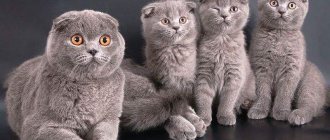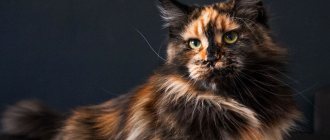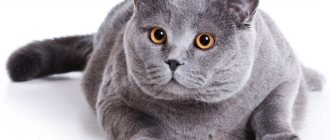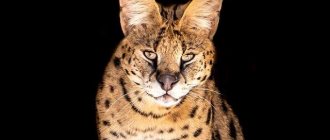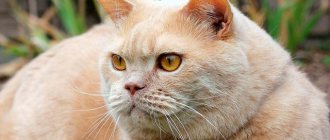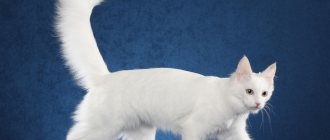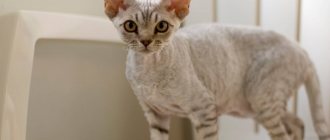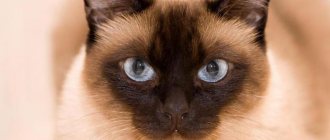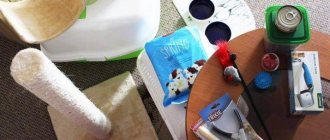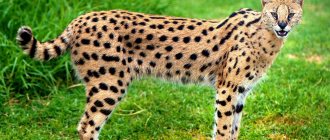Scottish Blue Point cats
The color of blue point Scottish cats (translated from English as “blue-point” means “blue dot”) is very beautiful. These are completely unique shades of light fur - the main color and shading on the paws, muzzle, ears and tail. Many people want to get just such a cat, because she is fabulously cute.
In the photo: Scottish Fold Blue Point
In the photo: Scottish Straight blue point color
The blue point color is associated with the phenomenon of acromelanism - the dependence of the intensity of coat coloring on temperature: in places where the body temperature is higher, the coat is lighter, and vice versa. While colorful kittens are in the mother’s belly, they are completely light, because their body temperature is uniform. But within a few days after birth, Scottish Blue Point kittens begin to darken their paws, tail, face and ears due to the fact that the temperature of these parts of the body is lower than the rest. This effect is associated with the action of the enzyme tyrosinase, which is responsible for the synthesis of pigments. By the way, for the same reason, colorful cats can change color slightly depending on the air temperature - sometimes darker, sometimes lighter. In addition, this color changes with age.
The color gene in cats determines not only the color of the coat, but also the eyes, which remain blue without changing to golden in adulthood. Blue eyes are the dream of almost every cat owner. And the main thing is that in this case the blue-eyed gene is not associated with deafness, as happens in pure white murkies. As a result, we have unique shades of eyes and fur, which, as a rule, are liked by absolutely everyone, even those who can’t stand Chocleate Point cats (“chocolate point”), which are associated with Siamese and create the impression that they stuck their muzzle in chocolate.
Color of British cats color-point (color-point)
Seal-point (Seal-point BRI n 33) Markings are dark brown, body is light cream.
Blue-point (Blue-point BRI a 33) Markings are light blue, body is white.
Chocolate-point (Chocolate-point BRI b 33) Markings – chocolate color, warm, rich tone, body – white.
Lilac - point (Lilac-point BRI with 33) Markings - lilac, warm tone, body - white, magnolia shade.
Red-point (Red-point BRI d 33) Markings are warm red, body is light apricot.
Cream-point (Cream-point BRI e 33) Markings are cream-colored, body is light-colored.
Tortoiseshell color-point The color of the markings as a whole should be the main color - seal, choclit, blue, lilac - with spots of red or cream. Ideally, all markings should have spots of red or cream in color. The paw pads and nose mirror correspond to the color. Seal-tortie-point (Seal-tortie-point BRI f 33) Markings – blue point with cream spots, body light cream. Blue-cream-point (Blue-tortie-point BRI g 33) Markings - blue-point with cream spots, body - light cream. Chocolate-tortie-point (Chocolate-tortie-point BRI h 33) Markings – chocolate-tortie-point with red spots, body – light apricot.
Lilac-tortie-point (Lilac-tortie-point BRI j 33) Markings – lilac-point with cream spots, body – light cream.
Lynx (Tabby) point There should be a clear “M” pattern on the forehead, a pattern around the eyes, and the mustache area should be spotted. On the front legs, torn rings from the toes go upward. Stripes on thighs; the back of the hind legs to the hock is solid color. The ears are solid color, but with the obligatory “thumb mark” (a spot of a lighter tone on the outside of the ear), which is less noticeable in diluted, weakened colors; In the tortie-tabby-point color, the ears (depending on the base color) have red or cream spots. The inside of the ear is lighter, as are the tassels. Tail with unfinished rings. The nose is pink with a border of the main color. Paw pads of the same tone with markings. Links always have only one color code - 21, i.e. the presence of stripes, without specifying which ones, because According to the standard, the body must be so light that any pattern on it cannot be determined.
Blue point color standard
A straight-eared or fold-eared Blue Point Scottish cat should have a blue mask on its face and the same markings on its ears, paws and tail. The rest of the body is almost white: without markings or patterns, blurred spots and yellow tones. All this is considered a disadvantage.
A good point color that will last a lifetime is quite difficult to obtain. Small kittens often have high-quality coloring that matches the standard, but as they grow older, the body may darken, which is a big disadvantage.
The ideal point color works well when both parents of the kitten are also points, and not in the first generation. Conversely, there is a greater chance of getting a darkened body if the parents were of a different color, for example, solid (solid).
The eyes of a blue point cat, as we have already said, are blue. The darker, more saturated, “deeper” the color, the better. Cats with light eyes (and often they are not at all expressed, grayish) are valued less.
Colories with decent eye color often have disgusting coat texture and a rustic appearance. The British often have weak bones, the Scots have short, problematic tails and ears that are not laid back well enough. These disadvantages are related to similar problems with shaded colors, which are most often used to produce color points. Yes, there are already some British people with decent hair and decent type, but there are only a few of them. As well as in the colorful colors worthy of the Scottish ones, there are only a few. British colors, obtained from blue, lilac, and patterned animals, most often have good bone and coat. In some places there is even a good contrast, but for the most part they have an extremely pale eye color. Scottish breeds bred from colored stock are also pale-eyed. They have a positive chance only if they are obtained from stable lines imported at different times from the USA and Canada. Local stock bred from the British will produce British-like variants with all the characteristic nuances.
Solid colors
The classification of color takes into account the characteristics of pigmentation, fixing them in the name.
Seal point (black)
Cats of this group are distinguished by a deep shade of black mask (sometimes with dark brown transitions), which also covers the areas of the limbs.
The coat on the body is light, in white, beige and cream colors.
Blue point (blue)
The pigment should be clearly visible against the background of the main color. The body coat is as close as possible to cool white, but the international standard also allows gray-blue.
It is important that the mask clearly contrasts with the body and does not have stretched transition zones.
Lilac point (lilac)
They are born almost white, but quickly lose this color. The main color is characterized by warm light purple tones, and a gray-pink mask covers the limbs.
In youth, the contrast is weakly expressed, but with age it gains pigment and is easily read on the coat.
Red point (red)
Another rare representative of the color point group of cats. The color tends from white to pink or peach pastel tones, and the points are expressed by orange-red markings.
Cinnamon point (cinnamon)
Perhaps the most unique color. Obtaining offspring with this color is an undeniable success for any breeder. And if the CS gene is added, then the value of victory increases a hundredfold.
The main coat on the body in warm shades of ivory is complemented by rich brown color-point pigmentation that extends into the red spectrum.
The problem is that this variant is easily overwhelmed by other species that suppress the cinnamon shade and transfer them to their own groups.
Chocolate point (chocolate)
The chestnut-brown color of the spots and the coat in shades of ivory is a rare combination that color point kittens can boast of.
Cream point (cream)
Delicate light cream color of the cat's body with acceptable variations in all shades of baked milk. The mask on the limbs is a thick chocolate color, contrasting, with clear boundaries of the pattern.
Interesting: Cream and red kittens often have problems with classification. They completely bloom only after a year of life. Therefore, at a young age, experts often question the color of, for example, a British pointing cat.
Blue point color genetics
Point belongs to the black series of colors, because, from the point of view of genetics, blue is nothing more than a diluted, or rather rearranged, black pigment. But blue coat genes B (black series) and d (dilution gene) alone are not enough to get a point kitten. A couple more recessive cs genes are needed, which displace the pigment into the marking area.
The ancestors of the Points are Siamese cats, which is why the color is also called Siamese. In Thailand it is considered sacred because... he was taken out by the monks in the monastery.
Today, among Scottish cats, the color gene cannot be called so rare, but breeders often value its carriers higher than solid blue cats. There are even entire nurseries that specialize in the reproduction of Point cats.
You can get a point cat even if both parents, for example, are gray (that’s what people call them, although they are actually blue). The main thing is that they are carriers of the desired gene. But even if they carry this gene, the chance of having a colored kitten is 25%. It happens that the color gene appears after 2-3 generations. For example, the kitten’s great-grandparents were colorful, but the gene did not manifest itself in the form of color in the parents. At the same time, two color point parents cannot produce a kitten of a color other than color point.
The international designation for the blue point color is a33.
What does genetics have to do with it?
Many people are probably wondering: how did it happen that all the representatives of this group are colored so uniquely? To answer this question, you will have to go back many decades and remember that cats became the object of attention of specialists in the second half of the 19th century. The British then began to perceive them as purebred animals and specially breed certain species.
The color point color is found in cats such as Ragamuffin, Highland Fold, Balinese, Siberian and American Shorthair.
The Siamese and Persian cats marked the beginning of the official registration of cat breeds. Later they became the progenitors of many modern cat breeds, including color points. Siamese cats came to Europe in 1870 and became favorites of many families. Blue eyes and unusual coloring are what attracted me in the first place.
Some scientific facts.
The color of the coat and eyes depends on a polymer pigment called melanin. It is formed from the amino acid tyrosine under the influence of the enzyme tyrosinase. It is this enzyme that is controlled by the gene that determines color, which is called Color. This gene is designated by the letter “C”. When the C gene is mutated, no active tyrosinase is produced and the pigment does not appear. In this case, the cat is born an albino, that is, uncolored. And the mutated gene is already indicated by the small letter “c”.
Where did these black spots come from then?
Scientists have discovered the Himalayan cs, or ch gene, which is also formed from a mutated C gene. But in this case, the enzyme tyrosinase becomes heat-sensitive, that is, depending on the temperature, it changes its activity: at high temperatures, tyrosinase is inactive, and as soon as the temperature drops, melanin in the cells it begins to produce and color the cooled areas of fur in darker colors. This is how the Siamese color turns out, which, by the way, is found not only in cats. In the last 30–40 years, geneticists have developed a large number of breeds that differ in color point color.
Strabismus in point cats
Cats of any point color (and there are not only blue, but also seal point, lilac point, lynx point and other variations) can experience convergent strabismus, which is characteristic of cats of the Siamese, Thai, Oriental and Burmese breeds. This defect, geneticists believe, is a byproduct of the action of the cs point gene.
Often in point cats you can find a violation of the projection of the optic nerves: part of the visual pathways from the eye goes to the side of the brain opposite to the norm. To compensate for this feature, strabismus appears, which allows the cat to build the correct visual picture.
Blue point color and character
There is an opinion (not a proven fact) that the Blue Point Scotsman is a cat with character. The fact is that the blue colors of the Scots were originally obtained from British cats, known for their temper. Modern Scottish Folds and Blue Point Scottish Straights are somewhat similar in character to the British: they are independent, willful, and can be aggressive if they don’t like something. However, the degree of expression of these qualities depends on the presence of British cats in the immediate family. If there are a lot of British people in the document, you should expect a tougher character, and vice versa. However, British genes will still be softened by Scottish ones, so such cats are more sociable and kinder than their British counterparts.
Caring for point cats
In general, care for point cats is the same as for cats of other colors. But it has its own characteristics.
Point cats cannot be cut or shaved: this leads to the appearance of darker areas of the coat. In the photo below you see the “panties” of a point cat, which formed after shaving before sterilization. This feature of this color, of course, does not mean that a Point cat cannot be operated on: a mark on the stomach does not make the animal less beautiful, because it is practically invisible. But, if you trim your cat's entire hair or in prominent places, or shave it, this can cause it to become dark throughout the body, and this will ruin its appearance.
Inept use of a fruminator when combing can also lead to bad consequences, because... With this tool it is easy to damage and cut off hairs, resulting in the undesirable effect of darkening the fur. If you do not know how to use a furminator, it is better to opt for a special paw for combing cats.
Also, the color of the point, as we said above, reacts to the ambient temperature: the lower it is, the darker the marks, and vice versa - in the heat, many cats become significantly lighter. Accordingly, don’t be surprised if your cat looks a little different depending on the time of year. The ideal temperature for keeping points is +25 degrees.
It is worth considering that the blue point color is a light color, and therefore easily soiled: dust and dirt in the house, settling on the fur, will spoil the appearance of the cat. Even if she is washed regularly, you will notice that the color becomes more interesting after a bath. This statement is not a call to endlessly bathe your pet, but advice on how you can improve the color if you suddenly notice that it has worsened. If the cause was contamination, advice will help. Although there are many other reasons for the deterioration of color point colors.
To improve the color, you can bathe Blue Point cats whose bodies are not light enough with special lightening shampoos. However, if the cat’s markings, on the contrary, are weakly expressed, then there is no need to lighten the fur further. Then you can choose any shampoo based on the problem (if any) or a basic one. We are talking about professional shampoos. It is better to avoid mass-market shampoos.
Some owners notice that food also affects the color of Blue Points: beef, carrots, beets, liver and seaweed can darken the coat. However, this has not been scientifically proven, and along with the owners who noticed changes in color depending on the diet, there are those who do not see any changes.
In the end, we would like to add that the point color of Scottish and British cats is one of the most unstudied: probably, its quality is influenced by a greater number of genes than is currently known to felinologists. So far, among the British and Scots, standard-colored point cats that have retained the excellent morphological characteristics inherent in these breeds are a rarity. The point colors within these breeds will still undergo changes: breeders have a lot of work ahead of them.
Source
Plain (solid, solid)
The monochrome uniform coloring of Scottish cats is considered classic by breeders. The solid or solid color of the animal implies the absolute exclusion of any inclusions, small marks and specks of a different color. The tone is rich, even along the entire length of the coat.
The most common used to be considered blue plain Scots. But today among the representatives of the breed there are many other variants of solid colors.
White
A Scottish cat with snow-white fur (without yellowness) looks luxurious. Possible eye colors are blue, amber, copper. According to the standard, eyes of different colors are allowed. The paw pads and nose are light pink.
Kittens may have markings of a different shade, which disappear after the first coat change. By the age of two, the coat of a white Scot should be crystal clear, without spots of a different color.
Black
The black cat has expressive yellow eyes. The nose and paw pads practically blend into the main color of the animal.
On the shiny bright coat of the Scottish beauty Ebony, 2-3 hairs of contrasting white color are allowed. The presence of large red or brown marks is not provided for by the standard.
Important: Scottish Fold pets are endowed with magical abilities. It is believed that it is the black color of the Scottish Fold that protects the house and its inhabitants from evil spirits.
Chocolate
The brown Scottish cat, also called chocolate, looks noble and impressive. The color of the coat contrasts with the animal's yellow, golden or copper eyes. The nose and paw pads are also dark brown.
Lilac (lavender)
The monochromatic lilac Scottish Fold has a gentle gray tint that smoothly turns into cream. The nose is slightly brownish, the paws on the bottom are the same color as the coat, in harmony with the main color of the pet. This lilac-lavender color goes well with eyes of copper, amber or orange shades.
Red (red)
Red or ginger color is a rare and valuable color of the Scots breed. The fiery edge is combined with burning amber irises. Pads and nose to match the dominant color.
The tail of kittens and adult animals is not very evenly colored. This deficiency does not disappear with age and is allowed by the standard. And the presence of marks on the head and limbs that remain after reaching the age of two are considered a deviation from the norm.
A red Scottish straight-eared cat can give birth to kittens not only with erect ears, but also with ears pressed to the head.
Cream
The cream or peach fold cat is infinitely elegant and beautiful. The delicate background of light fur, bright golden eyes and a pinkish nose give the pet an irresistible appearance. The pads on the paws are also pink. An animal with this color is similar to a red Scotsman, but its coat color is a shade lighter.
A peach fold kitten may have a blurry, fuzzy pattern on its paws and tail that does not disappear with age. This is not critical for a purebred pet, but leopard markings are absolutely unacceptable.
Faun (deer)
There is another unique color of Scottish fold cats with an interesting name - fawn, which means “young deer”. The nose and pads on the paws of these beauties are beige-pink.
Cinnamon
Cinnamon is a lighter and more delicate color than chocolate, but darker than red. The nose and paw pads of such animals are brown, beige or pink.
Blue color (blue)
The gray or blue Scottish cat has very beautiful amber eyes. The coat tone of a purebred pet can belong to any range of gray - from the lightest (blue) to completely dark (blue). At the same time, each hair is saturated and well colored, without streaks.
The nose and pads practically do not differ in color from the plain coat.
A gray Scottish Straight cat may be marked with a few streaks and drawings in childhood. But as they grow older, these color flaws go away.
What to feed a Scottish kitten?
Scottish cats are very fluffy and cute, many people dream of having such a pet. Their skin comes in different colors, from marbled to point. Scottish Straights (straight-eared Scots) originated in Scotland, as can be understood from the name. Only recently has the breed gained independence, because there is also a fold-eared variety. Such a kitty will bring a lot of positivity and joy to any home. She will get along well with small children, will not bite or scratch them, will gladly take part in games and fun, and when she gets tired, she will simply hide in her house. By the way, she needs a house - it is important that the animal has a place where it can retire and be in peace and quiet, without communicating with anyone and gaining strength.
Description
These animals have the following appearance features:
- weight about five kilograms for boys and three and a half for girls,
- rounded head shape,
- elongated graceful body,
- graceful plastic movements, mobility,
- forehead is convex, high, rounded,
- eyes wide apart, open, large, expressive,
- round muzzle, developed chin,
- Medium length and width of the paw, harmoniously combined with the body,
- the tail can be long and very long, tapering at the tip,
- The nose can be either medium or short. It is wide and with a recess,
- very soft, thick undercoat, hair does not fit tightly to the body,
- fur can be both short and long,
- The ears are small or medium-sized, rounded at the tips and wide at the base.
Determination of color
Color point is a derivative of a combination of two English words: color (color) and point (point). Its visual expression is characterized by the contrasting difference between the light body of the animal and the accentuated ends of the limbs.
The most typical representative of this class is the Siamese breed, from which, apparently, the entire selection line came.
The distinctive features of the color point color appear as follows:
- light monochromatic hair on the body;
- clearly visible darkening on the legs, tail and ears;
- a contrast mask on the muzzle that can spread over its entire surface or be located only in the nose area.
The color of the limbs and its saturation depend on additional reasons.
Interesting: All colorpoint kittens are born without signs of future pigmented areas, but they appear already in the first week of life.
Character
Such pets have high intelligence, they have an easy-going character, they are self-sufficient and reasonable. They tend to choose one of the family members, whom they consider their master, but they also love the rest very much, but they don’t sit in anyone’s arms. It’s better for the cat to sit next to you and press its side to the person.
Kids easily get used to a new home and other pets; they are quite comfortable with children and older people. They tolerate loneliness well. When everyone is at work, they don’t destroy the house and behave well. These are very obedient animals, they understand well what is possible and what is not. They are active, love to play, but always know when to stop.
Pets almost never use their claws or teeth; if you get too hard on them, they will rather go into a corner and hide there. They cannot stand rude treatment; if you yell at them, they can hide for a long time and not come out, getting offended. If you decide to explain to the purr that he did something wrong, it is better to just speak in a stern voice. This is enough, because he is smart and understands everything.
Color Point (Not Siamese)
What breed is this cat? Probably 90% of people who are far from felinology in general and cat breeding in particular will answer without hesitation - Siamese. Is this really so?
Unfortunately, a common mistake of many lies in transferring the name of the color characteristic of the Siamese and Thai breeds to all color-point cats.
What is this color point color and why is it called that?
Siamese cats have a lighter colored body than the protruding parts of the body - the points (muzzle, ears, paws and tail), which are more intensely colored. Therefore, this color is called “point”, that is, terminal.
Color point belongs to the group of acromelanic colors. Acromelanism is a phenomenon of incomplete albinism, when the intensity of coat coloring depends on temperature (!) - less pigment is produced in warm parts of the body than in cold ones, that is, on the ears, muzzle, paws and tail, which will be colored darker.
These individuals do not require special conditions and are very easy to maintain. They live well in apartments and do not need much space. When leaving home, be sure to leave your pet toys, food and water. Then he will survive this time well. Grooming for Scots is standard; you need to regularly trim their nails, wash their eyes, clean their ears, and comb out their fur. The latter should be done about once or twice a week, bathing rarely, as it gets dirty.
It is very important to love your pet and show him that he is important. In this case, he will feel great and live a long and happy life. Don't forget to monitor his health and give him medications for worms and fleas. Even a pet can become infected with them. If you plan to take him outside, it is better to get a harness to control his movement. He tolerates travel and travel very well and feels comfortable in the car.
Color point breeds
Selection research by cat lovers has led to the emergence of various breeds with color point color. They differ from each other not only in the shade of the color dots, but also in the basic tone. Let's list the main color point cats. The well-known Siamese color is called seal point. It should be noted that in America such cats are called Himalayan, because a similar color was known in Himalayan rabbits.
If a cat has a pair of Himalayan genes in its cages, then its fur on its limbs, tail and face will be dark brown. These spots do not turn black because the enzyme tyrosinase in Siamese cats is not active enough, and the formation of melanin does not occur so intensively as to polymerize. The eyes of Himalayan cats should be blue due to the small amount of melanin in the iris. The richer it is, the more purebred the cat is considered.
Its relative, the Thai cat, is very similar to the Siamese cat. It has many varieties, depending on the predominant shade. But they are united by one feature: the body has a certain color, and the limbs, ears and muzzle will always be painted darker. The Thai cat was bred using selective selection, as a result of which some characteristics of its ancestor, the Siamese cat, were changed:
- muzzle shape;
- color;
- body shape.
The Thai breed cat standard was officially adopted in Germany in 1990.
Let's compare cats of both breeds and determine what their differences are:
- The Thai cat looks much more massive, the Siamese has an elongated, graceful body.
- The Thai's muzzle is round, while the Siamese's is elongated.
- The Thai cat has rounded eyes, while the Siamese cat has pointed eyes.
- Thai cats have short and powerful legs, while Siamese cats have long legs.
The common features of all representatives of the Thai cat breed are affection and complaisance. They quickly become attached to their owners and can follow commands that they have been taught. They love to communicate: they meow and purr to carry on a conversation with their owner. But try not to offend them, as they remember the insult for a long time and can take revenge. Externally, Thai cats look very elegant: the muscles are well developed, the head is round, the eyes are blue, the coat is soft without undercoat. Their weight and size can reach 3 kg.
It will be interesting to learn about such an unusual breed as the Snowshoe.
The Red Point is a Thai cat with a white base color and a red tint on the legs, face and ears. Caring for and maintaining the Thai cat breed is not particularly difficult, as they are usually healthy, not susceptible to any special diseases, and their fur does not require combing. You can use standard food - either natural products or dry food and mixtures
Persian color point
Among all color-pointed cats, fluffy semi-longhaired and longhaired Siamese cats stand out noticeably. In 1931, American scientists set themselves the task of breeding a Persian cat with a Siamese color. They bred a purebred black Persian cat and a Siamese cat.
For more than 20 years, by crossing the brightest representatives of litters from Siamese and Persian cats, scientists achieved the birth of a pure breed Siamese-Persian cat, which combined the Siamese color and blue eye color with the nose and ears of the Persian breed. In 1955, the Persian Longhaired Color Point received official recognition. By the 70s of the last century, color point cats acquired a look more characteristic of Persian cats
British color point
Relatively recently, a British cat with color point color was bred. Let us remember that in America these representatives of the cat world are called Himalayan. The British Color Point is painted in light colors; limbs, tail, ears and muzzle contrast with the main color and have a dark tint. Their eyes are dark blue or deep blue. The Briton's coat is dense and dense.
Did you know? British Color Points are born albinos, and only after a few weeks do they show the well-known dark spots. Young cats always have a more pronounced color than adults.
The character of British Color Points is independent, but calm. They get along well with all household members and require a lot of attention and love. They have a developed hunting instinct: these cats are able to catch mice. If a Briton has a white coat with light blue markings, then he is called a blue point. The coat of a British cat has 2 levels: a dense undercoat, reminiscent of plush, and long guard hairs. Therefore, it requires special care.
Find out what gray, red and tabby cats they are.
To maintain the healthy appearance of such a coat, a Briton’s diet must certainly include calcium, essential vitamins and microelements.
A British cat should be checked for tangles in its fur and should be constantly brushed with a massage brush. When washing, use shampoos for short-haired cats. If you have British kittens, then they need additional care:
- wipe the eyes with a damp cloth from time to time to remove any accumulated secretions;
- ears are cleaned of accumulated wax;
- check for the presence of ticks in the fur;
- Nails are trimmed with a special nail clipper.
British Color Point kittens can be toilet trained. The tray designated for this should be in a secluded place and should be cleaned in a timely manner.
Scottish straight
Scottish Straight cats were bred in Scotland and are also called Scottish Straight cats. They were the result of crossing a Scottish fold cat with a straight-eared cat. Scottish Straight kittens until they are one month old have ears like their fold-eared ancestor, after which they straighten out and become straight.
This representative of the color points is characterized by features that are unique to him, in contrast to the British, with whom he may be confused:
- the head shape is more round;
- the body is elongated, graceful;
- significantly lower weight than the British (no more than 5 kg for a cat and 3.5 kg for a cat).
To accurately determine whether the cat you have in front of you is indeed a Scottish Straight cat, use the standards of this breed:
- the head is round on a thick neck; the forehead is slightly rounded, high and convex;
- the eyes are wide and round in shape;
- medium sized body;
- well developed chin, round muzzle;
- the nose is wide, small, has a depression along the entire height of the nose up to the forehead (visible in profile);
- The ears are wide at the head, rounded at the tips.
- the paws are developed in proportion to the body, the tail is long, narrowed at the end.
- the coat has a pronounced undercoat, the guard hairs can be long or short.
Scottish short-eared cats are distinguished by a good-natured disposition, do not require much attention to themselves, prefer to be close to the owner, and do not like to sit on hands. They become attached to one member of the family, but are peaceful with everyone.
Caring for a cat with point colors
Experienced breeders recommend paying special attention to cats with this color. The optimal air temperature is 25-28 degrees. When it sharply decreases, the fur will darken; when it increases, the marks will become lighter.
It is not advisable to add foods containing iodine and copper to your diet.
Thai cat with point colors
Long-haired cats need to be brushed daily. If matted hair has to be cut, darker hair will grow in its place.
Blue point cats, which appeared not so long ago, quickly won the love of breeders for their unusually beautiful colors. Those wishing to purchase a kitten of this noble shade have a choice of breeds and variations.
Caring for a Blue Point pet is not much more difficult than caring for any other cat.
If you decide to buy a baby with blue markings, I wish you good luck in raising him and joy in your future life with him.
Yes, the Scottish Fold is not the most capricious breed; they are quite independent and can be alone for some time without hysterics. They do not accept excessive activity on the part of humans, shy away from overly intrusive children and do not welcome fuss and noise.
We suggest you read: Choosing food for Scottish Fold
They love to be around people. They enjoy watching everything that happens in the house. They can follow on your heels, but not give in to your hands.
Point colors of the Scottish Straight cat
This color is often called “Siamese” by cat lovers. The main characteristic of the Point is that the legs, tail, ears and muzzle are darker than the main coat. The following variations are allowed:
- Blue point - as the name implies, there are blue marks in the areas indicated above. It is preferable that the blue is not very dark. The main coat is white.
- Cream point is a completely cream color. Only the main part of the fur coat is painted in a lighter shade, and individual parts are painted in a darker shade.
- Cream Blue Point is a rather interesting variation, in which the body is grayish-cream, and the muzzle, paws, ears and tail are dark gray.
- Lilac Point – there are purple markings on the snow coat.
- Chocleate Point is a very beautiful color, in which specks of a rich chocolate palette adorn the snowy coat.
- Chocolate Smoke Point – a whole scattering of chocolate! The main surface of the fur coat shimmers with a light variation of brown, and the remaining necessary areas are dark.
- Red point - the white cover is marked with red areas.
- Tortie point - in simple words, it is a tortoiseshell color mixed with cream or red spots.
- Tabby point - light coat marked with striped areas in the right places.
Whatever the point variant, the eyes should in any case be colored blue.
These cats are extremely careful and reasonable. Cleanliness is also their calling card.
Colors of Scottish cats (photos and names)
Plain or solid
Scottish fold cat color lilac solid
Scottish fold cat color blue solid
Scottish fold cat color black solid
This color of a kitten’s coat does not include the presence of minor inclusions and is characterized by relative uniformity. Solid Scottish cats can be blue, black, cream, lilac, "fawn", "cinnamon".
▲ to contents
Tabby or tabby
Tabby (tabby) has common features for its three subclasses, namely:
- a clear mark on the cat’s face in the forehead area in the form of the letter “M”;
- horizontal stripes leading from the cheeks towards the body;
- marks on the face;
- edging of eyes and nose.
This type of coloration of Scottish Folds, in turn, is divided into:
▲ to contents
Tiger (mackerel)
Scottish straight cat, brindle tabby (tabby) or mackerel color
characterized by a uniform distribution of vertical stripes on the sides of the animal’s body, reminiscent of a tiger pattern.
▲ to contents
Spotted
Scottish fold red spotted tabby cat
It assumes the presence of a vertical (possibly intermittent) stripe along the entire body of the animal and clear rings framing the tail, neck and paws of a Scottish Fold or Straight.
▲ to contents
Marble
Scottish fold cat color marbled silver tabby (tabby)
It stands out among other tabbies due to the figures drawn on its body in the form of patterns reminiscent of marble stains.
Tabby is infinitely varied in color: black, gold, silver, red, etc.
▲ to contents
Tipped
With this type of dyeing, the cat’s fur is colored in 2 tones:
Smoky
Scottish straight cat, black smoky color
- the base of the hair is colored silver, and the end can vary between chocolate, blue and black.
▲ to contents
Veiled (chinchilla)
Scottish straight cat, blue and golden chinchilla color
Scottish fold silver chinchilla cat
– the tip of the hair is colored approximately 13% of the entire length, the remaining 87% is a light milky shade. The upper part of the hair is gold, golden-blue and silver.
▲ to contents
Shaded
Scottish straight cat, shaded golden color
– about 30% of the upper part of the hair is colored (red, golden or silver), the rest of the hair is white.
▲ to contents
Tortoiseshell
Scottish fold cat, tortoiseshell color
This Scottish Fold/Straight coloring is distinguished by the uniform distribution of red or cream spots on chocolate, black or blue wool. Only cats can boast of such unusual diversity; cats, even if they become owners of the coveted fur coat, will not be able to produce offspring.
▲ to contents
Colors with white inclusions
Bicolor
Scottish fold cat color red tabby (tabby) bicolor
Coloring involves a combination of two colors on the coat of a Scottish cat: necessarily white and, for example, blue, black, red or tabby.
▲ to contents
Wang
Scottish fold cat color Van
This type is characterized by an underlying white coat and, at the same time, a tail and muzzle painted in any other color. Small colored inclusions on the animal's body are also possible.
▲ to contents
Harlequin
Scottish fold cat, harlequin color
This coloration also implies a white base and the presence of various spots of excellent color throughout the body and always on the tail. The number of spots varies from 16 to 20% of the animal’s entire fur coat.
▲ to contents
British cat Blue Point BRI a 33: color standard
The body of a British Blue Point cat should be very light, from cold white to gray-bluish. The point markings should be blue.
In this color it is important to maintain contrast, since the blue tone itself is quite light, so when mating it is important to choose the right partner in order to maintain the richness of the point marks.
The eye color of British Blue Point cats is blue or blue, but again you need to monitor the brightness and intensity of the blue eye color in order to maintain contrast.
The nose and paw pads are gray-blue.
With age, Blue Point British cats gain color and the color becomes more intense, often darkening.
Variations
In addition to the classic blue point, today there are several more variants of this shade:
- In Blue Tabby Point , the markings on the paws and face are not uniform, but striped (tabby). On the forehead the stripes form the letter M.
- The Blue Ticked Point is a recent development and is very rare. It originated from Abyssinian cats and is distinguished by the fact that a ripple effect is visually created on the body, making the fur look like the skin of a rabbit or chinchilla.
- In the Blue Cream Point , blue-gray markings are evenly mixed with cream. The nose can be either dark or pink.
- The blue tortie point has a tri-color tortoiseshell pattern. This is a chameleon color that changes its appearance throughout its life. Each cat of this shade is unique due to the arrangement of bluish-cream markings.
Blue cake point
Features of mating British blue point dogs
The bluepoint color is quite difficult to breed, since the cs gene is recessive (suppressed). Only when both producers (male and female) have such pigment colors, the kittens in the litter will be guaranteed to be pointing only. Parents with smooth, monochromatic hair who are carriers of the cs gene can also produce children with Siamese pigmentation, but with a 25% chance. If a Blue Point female or male is bred with a carrier of the gene, half of the kittens are born white and then acquire the characteristic blue markings.
Source
Color features
The color mask of the limbs in animals with acromelanism (incomplete albinism) varies depending on the base tone of the coat. It is never pure white, but lightens in harmony with the characteristics of the recessive CS gene.
Therefore, for example, the rich brown mask of a color-point cat accompanies a fawn shade, and red pigmentation stimulates varieties of the cream range of the color palette.
In total, the group combines about 20 different coloring options, from traditional dark to exotic lilac or wine.
